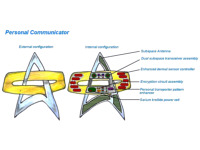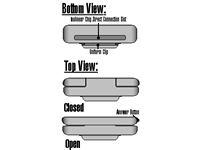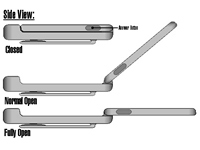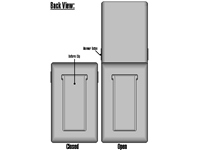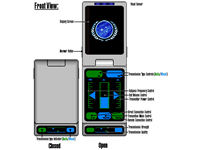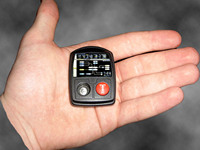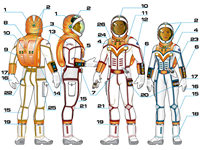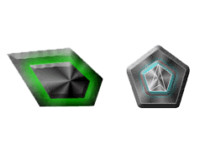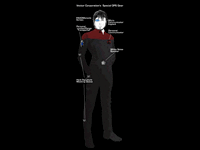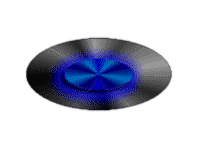Personal Equipment
Equipment, Personal Equipment, Personal Weapons
Personal Cloaking Device
Devised by The Admiral
Length: 5 in
Width: 3 in
Weight: 4g
Power source: Self charging quadresium power cell
The Federation agreed not to use cloaking devices when it signed the Treaty of Algeron in the early 24th century. However, they only agreed to not use cloaking devices in their space vessels. This gave Starfleet the idea to adapt the personal cloaking device for use by Starfleet Marines and Hazard Team personnel. The concept was developed by Starfleet Intelligence and Section 31, in association with Klingon and Vulcan scientists in 2370. The preliminary tests did not go well, and the concept was forgotten. In 2376, with Starfleet needing better technology for stealth operations, testing resumed. This time, testing fared much better than it had 6 years previous. The prototype was completed in 2378, and it is powered by quadresium, an isotope that is immune to all known energy dampening fields, and is found in abundance on Rigel III. Operating the device is very similar to operating grav boots. All that needs to be done is for a button to be pressed, and the device is activated. Holodeck simulations of the prototype went well, and has been mass produced for Starfleet Marines and Hazard Team personnel, but there has been no field testing of the device as of yet.
Personal Communicator
Devised by James Keen
Motivation
Standard Starfleet communicators are all fine and well for the average ship to ship and surface to ship transmissions, but what about when things get a little rough, like for instance when it is necessary to transmit through some heavy interference, or in times when there are some major barriers that the user has to beam through, in times like this the standards personal communicator is rendered useless, this is where the new and improved personal communicator comes in.
With a personal transporter pattern enhancer, and a dual subspace transceiver assembly built in this is the communicator of the future.
Dual subspace transceiver assembly
For a long time it was customary to have only one subspace transceiver assembly present in communicators used by Starfleet personal, in theory this worked well, but in practise it regularly failed. How many times have you been standing on the bridge of your starship and trying in vain to contact your away team down on a planets surface only to hear your communications officer tell you that they can't get through, due to interference. A dual subspace transceiver assembly can give the signal an extra push, an extra little bit of 'something' maybe just enough to get through the obstruction. To you this can mean the difference between getting through to your away team, sending medical teams and extra supplies or not being able to contact them. To your away team, this can mean the difference between life and death. Can you take that chance?
Personal transporter pattern enhancer
But let's say for the moment that you are able to get through to your away team. You boy-wizz of a conn officer manages to reroute power from the internal sensor grid to the external communications array, and they convey to you they need extra weapons and a medical team there as soon as humanly possible. What do you do? You can't beam them back to the ship, due again to the original interference that stopped you communicating in the first place. You can't send a shuttle down; it will never be able to land in the cosmic dust storm that just pulled in from the north, so that also knocks out the idea of sending them the supplies, let alone a medical team. So you are stuck. All you can do is stand their on your bridge and listen your crewmates, maybe even personal friends, cry for help as the alien that is attacking them slowly and painfully devours them. If only you could get three pattern enhancers down to them.
With this new and improved com badge each individual crew member will be wearing a personal pattern enhancer, enabling you to beam them directly to where ever they need to go, be it your transporter room, sickbay, the bridge or another part of the planet.
The replicator pattern for the new comm badge design is due to arrive on most star ships via subspace no later than stardate 49765.2. Please do your best to distribute one new comm badge per crew member.
Mark VIII Personal Communicator
Design by Lt. Draz Tyler
Length: 10cm closed, 16cm standard open, 17.5cm full open
Width: 5.5cm
Thickness: 1.5cm
Weight: 120g
Power Source: internal sarium krellide cell (average lifetime 12 months)
Transmission Types: audio and full colour visual
Transmission Modes: continuous, data burst, period update
Standard Maximum transmission/receiver range (visual): 900,000,000,000,000km (0.09ly)
Standard Maximum transmission/receiver range (audio): 1,125,000,000,000,000km (0.12ly)
Boosted Maximum transmission/receiver range (visual): 1,005,000,000,000,000km (0.11ly)
Boosted Maximum transmission/receiver range (audio): 1,300,000,000,000,000km (0.14ly)
Other Features: mark III universal translator, algorithms external direct connection and power, transfer port
Communicators were hand-held communication devices used on Starfleet away missions and where normal shipboard communications were inaccessible during the 22nd and 23rd century. Employing a flip-top design, a Starfleet officer spoke directly into the device to give voice commands and speak with other personnel. However in the 24th century, communicators were integrated with uniform badges and became known as comm. badges which have been used for most of the century.
However, increasingly over the years, it has become obvious to many that in some respects comm. badges had some limitations compared to earlier communicators. Theire small size limited their range and they were dependent of a starship's computer for operation. This weakness was particularly noted when a starship was disabled, as without the computer, crew often found themselves unable to communicate with each other. The range problem was compensated for by fitting a second subspace transceiver. However, Starfleet soon decided to reintroduce the communicator unit as a compliment for comm. badges for exploration duties and hazardous situation where comm. badges were shown to often be a liability. Thus in 2379, the first new communicator unit was built, the Mark VIII.
The new Mark VIII communicators made use of all the latest developments by Starfleet. Powered by a sarium-kellide cell capable of lasting 12 months on a full charge, the Mark VIII has a range of nearly 0.1 light years, scan and receive across a range that covers almost two thirds of the entire subspace frequency range and yet still only weighs 150 grams. Due to it larger size than a comm. badge, the Mark VIII is fitted with four subspace transceivers and a more advanced universal translator, substantially improving its transmission power and range. The additional transceivers also allow the Mark VIII to have several transmission modes in addition to the normal continuous transmission, including period transmission with a break in-between and data burst transmission mode, a mode which compresses data being given to the communicator and transmit it in a single short burst, making transmissions very hard to detect and locate. More importantly however, these additional transceivers, combined with the latest development in PADD display technology, has allowed the Mark VIII to incorporate a visual transmission ability, allowing for the first time visual contact between away parties and their ship without the need for a third party, allowing for additional security.
Another feature added to the Mark VIII, in addition to a remote link for interfacing with a tricorder or computer system for data relay (a feature also included in comm. badges), is an external direct connection and power transfer port, which allows the communicator to be connected directly to a computer system or power source for either direct data download to a orbiting starship, or as a source of power allowing the unit to boost its transmission range even further. This port also accepts isolinear chips which, as a result, can be an additional security feature, by either carrying a detailed encryption algorithm for a comm. signal or acting as a key and stopping the communicator working if it is removed. Field test of the Mark VIII has shown it to work well as a compliment to the comm. badge, perform much better in hazardous situations than the comm. badges.
Datalink - the Bridge in Pocket Format
Devised by [email protected], translation by Bernd, ASDB Member
Abstract
The Datalink is an invention that was never intended. More exactly, the prototype was being developed by the single construction teams of the Taranis Project virtually on their coffee breaks. Not really for use on starships, but rather to facilitate work during the construction phase. It was nothing unusual for the engineers and technicians to bridge kilometers between the offices and the single computer terminals. This may have been beneficial for their physical fitness, but it had become bothersome after a while. So the desire of laziness enabled a technical innovation: the Datalink. A small unobtrusive device that helps solve all mobility problems.
Description
But what exactly is the Datalink? Basically speaking it consists of a subspace transceiver, a small display, an energy cell, a few isolinear microchips and a small holoemitter. No! Stop! Some of the readers may think this is just another article about a certain device from the 29th century, but it is not. Actually, the Datalink is nothing but a workstation. But this requires some additional explanation. The basic idea is a device that allows (within its range of communication) to access an process all data from a central computer. Agreed, this was already possible with conventional tricorders. But these were not adequate by far to display all types of data, much less was its keyboard suited for complex input. This is why more "space" for a user interface was required. What about PADDs? They are small, handy, may be used universally, and if they are somewhat larger they are sufficient to type on them. This is what has been used as an improvised workstation so far. But it caused new problems: It is true that a PADD offered the space for more keys, but we are talking about an engineer who wants to work everywhere with the very same console. Also, with the same user comfort as on his desktop computer station at home. In addition, it is necessary to carry these things along all the time. Even two or three of them if one wanted to cover different topics. Thus, PADDs are too complicated either.
What was needed was an adaptable interface. Verbal commands would be welcome too. We sat down and gave it some thought. The best we came up with was a portable device capable of creating holographic consoles. Initially, this was not a really serious idea and it didn't find much attention. Why that? Because, in order to create a decent replica of a computer terminal, it would have required a device of the size of a wardrobe trunk (inluding all the power systems, computer capacity etc.). Not overstating, this would have been too bulky. But then the team began to think more economically. Was a complete console required? Wouldn't a mere user interface suffice? It would simply hover, only have a length and width. To calculate the hologram, one would use the computer that is being accessed. But what about data safety? It doesn't seem recommendable to transmit highly sensitive data over hundreds of kilometers. It would also be a lot of data, requiring a high bandwidth. To fulfill all these criteria, our Datalink would need its own communicator (or something comparable). This is why we have incorporated one. But instead of simply taking it as it is we have conceived something "space saving". The Datalink does not establish a direct comm link to the respective computer, but employs the communicator of the operating officer as the main transmitter/receiver. This has multiple advantages: It saves a lot of space, as only a data link to the communicator, at most three meters away, is required. In addition, the comm channels of communicators may be encoded easier and faster (if they are not already encoded anyway). Moreover, newer communicators may be adpated to their respective users. This allows to restrict usage to this single person.
Conclusion
Summarizing, the Datalink is a device that allows the user to access the main computer anywhere within the communicator range. In a radius of about two meters, the device allows to recreate any user interface that is available on the computer (that is, about any known interface). It is possible to work on computer terminals that are not inferior to a real bridge for two to ten hours, depending on the number of displayed interface elements, the transferred data volume, the holographic display quality etc.).
The Datalink has quickly become an important instrument during the construction phase of the Taranis. There were no limits for the use of this device. It was possible to do one's work everywhere. When the ship was later launched, the designers who are now working on the ship saw no reason to abandon this invention. It is currently used on away missions, where it helps avoid carrying bulky equipment. In the meantime it is possible to link the Datalink with a tricorder, allowing to analyse gathered data at once and on a fully equipped scientific terminal, and send data and results to the ship. On the Taranis itself the little device has not really prevailed. After all, there is a fully equipped multifunctional console around every corner.
Extra Vehicular Activity Suit (T'Suit)
Devised by Gustavo Castillo
After her own daughter A'Rik got stranded in deep space with only her E.V.A. suit after the explosion of the shuttle in which she and a human crewmate, also stranded, were traveling back to their starship, Dr. T'Lep, Chief Medical Officer of the U.S.S. Stubborn, decided that personnel in such predicament should have a bigger chance of survival. A'Rik could be rescued just before her resistance gave up, only by means of her greater Vulcan physical strength and meditation discipline, which allowed her to lower her metabolism. Even though she tried to help him relax and save energy via telepathic connection, her human partner wasn't so lucky and passed away during the resuscitation procedure at sickbay.
There has to be a way to extend the astronaut's life time, time enough to make a rescue operation possible, by toning down the body functions for a certain period of time without the aid of meditation techniques or medication, in other words, a stasis, or suspended animation, condition. Of course, the logical solution was to turn an E.V.A. suit into a portable stasis chamber. Easier said than done. Even assisted by Chief Engineer Tung, It took them a year and a half of experiments and simulations to finally accomplish the task of miniaturizing a working stasis field generator. The fact that an E.V.A. suit is a contained, isolated, environment improved the working conditions of the stasis "chamber". They placed the generator into the upper side of a bigger (bigger than in previous standard models) back pack, just above the air recycling system. The homogeneous distribution of the field is performed by a series of conducting stripes running along the whole suit. These stripes have a triple purpose:
- The emission of the field in stasis mode.
- In normal operation mode they regulate the temperature of the user's body and
- identify the department in which the user serves (operations, command or science) by color.
To prevent the accidental activation of the stasis mode, the switch is located in the buckle of the suit and needs a very simple but precise sequence of pressing the five keys to start it. The induced state has a benevolent side effect: the person is unconscious all the time, therefore, protected from the psychological damage produced by long periods of solitude and isolation. A huge power cell sustains the whole system and allows a stable stasis field for more than 45 solar days. A subspace beacon transmits an intermittent distress signal in all available channels, also indicating the position and identity of the stranded individual. The new outfit has another useful feature incorporated: a built-in tricorder. A series of well distributed sensors provide readings of the surroundings and can be controlled by the left fore-arm control key pad. The displayed data is projected holographically on the lower half of the transparent aluminum visor of the helmet. Senior staff, department heads and specialized personnel in maintenance and repair services of the outer hull, about 70 people, have their own tailored and personalized E.V.A. suit. Those crewmembers who occasionally do work on the outside the ship or missions on planets with a non friendly atmosphere use the same equipment but with interchangeable parts to fit all sizes.
After approval from Starfleet Medical first and Starfleet Command later, the "E.V.A. Long Term Survival Outfit mod. 0532/01", here to fore affectionately called "T'Suit" in honor to its Vulcan creator, became Starfleet's standard issue. By Stardate 55271.6, 20% of E.V.A. garment in Starfleet were replaced by T'Suits.
Note: Although his participation was pivotal, according to Dr. T'Lep (who tells that to anyone who would listen), in making the T'Suit a reality, Lt. Commander Tung denies any credit for its creation, saying that his job was "merely provide technical support to the brilliant ideas of good Dr. T". In spite of that, when Starfleet Medical decorate Dr. T'Lep with the Leonard McCoy Award for "Medical Solutions to Practical Problems" for her creation, they also presented an Honorific Mention to Lt. Commander Tung for "Outstanding Contribution".
Picture reference
1. Helmet
2. Sensors
3. Helmet left-right rotation servos
4. Headlights
5. Suit systems status monitoring display
6. Tricorder and main systems control pad
7. Stasis initiator buckle
8. Upper back pack: stasis field generator system
9. Lower back pack: air supply recycling system, suit's pressure controler
10. Starfleet emblem
11. Name tag
12. Federation emblem
13. Starship's identification patch
14. Power cell
15. Colored Stripes: Body temperature regulators (normal operation mode) - stasis field emitters (stasis mode) - department color indicators
16. Gloves
17. Gloves air seal
18. Magnetized boots
19. Boots air seal
20. Magnetized boots and body temperature control
21. Knee pads
22. Safety grapple connection rings
23. Regulation phaser pistol
24. Rank pips
25. Side pocket
26. Chest plate: other life support systems (heat generator, cooling system, vital signs monitoring)
The Monocle
Devised by Ensign Fox
The Vector 9 Special Operations Monocle is the latest in a long line of special OPS equipment designed by the Vector Corp. for Starfleet. The Monocle is a compact PADD that has low memory storage space that is perfect for the short-term field and intelligence operations. Combined with this is Infrared and Nightvision modes for assisted vision. The Vector 9 has a max. running time of 70 hours without charging. They are currently being used for Medium to High level operations and most intelligence missions. Skin Molding Memory Mesh contours the device to the area around the wearer's eye.
Thermal Signature Masking Device and White Noise Speaker
Devised by Ensign Fox
For operations that require high levels of stealth and infiltration, Vector Corp. introduces The Thermal Signature Masking Device. It attaches to your uniform and comes in a set of 6 sensors and Spatial Heating and Cooling systems regulate the surface of your body to the surrounding temperature, masking your body from heat signature based devices. Also, from Vector Corp. comes the White Noise Speaker. It wraps around the wearer's body like a belt and emits a soft unnoticeable background sound that drowns out any sound within 5-7 ft of the device.
Personal Limited-Range Transporter
Devised by Ensign Fox
Vector Corp. introduces the Personal Limited-Range Transporter. Worn as an arm patch, this Personal Transporter is perfect for Field Operations requiring a quick escape from dangerous situations. Although its size makes it a convenient tool to have, it also limits its range to 40,000 ft.
Duty and Dress Uniforms
Design by Gustavo Castillo
New duty and dress uniforms.
Duty uniforms
Back to a two color scheme, the new design for duty uniform (1, 1a, 1b and 1c) is unisex and consists of a three pieces suit: black trousers over black short boots, turtle necked black shirt with colored details and a waist level, "V" shape necked black jacket, opened at front, with a very stylized wing like design on the shoulders and cuff bars, colored according to department area. The captain has an optional uniform (2), more casual, includes a burgundy shirt with black details, black knickerbockers tucked in combat boots and a black vest with lines the same color as the shirt. For heavier duties there's the jumpsuit (3), a one piece overall fastened at waist level, colored according the service division, with black details over a collarless shirt in black and combat boots. Security personnel wear jumpsuits when in watch duty. Academy cadets uniform (4) is a short windbreaker over a turtle necked one piece jumpsuit, all in grey with white lines and black combat boots. Admirals wear (5) a black shirt with burgundy details, trousers and shoes in black and a hip long coat in black and grey with gold and burgundy details. Rank pips and communicator placing remains unchanged.
Dress uniforms
These are the new dress uniforms, in male and female version, according to the change of duty uniforms adopted recently by Starfleet. Commissioned Officers: (7, 7a and 7b) composed of a turtle necked shirt colored according the department of the wearer, details in gold, black trousers, or tights in the female version (7a) and shoes, with a white jacket thigh level long (knee in the fem.), ornamented in gold and departmental color, same as the belt. Captain's uniform has a little more gold (7). There's also the new admiral's uniform in formal version (6) same as the others, only with white shirt and divisional color replaced by black (and more gold). Female personnel may opt for the same configuration as the male's uniform (7b). Ensign and Lieutenant Jr. use a simpler "unisex" version with waist level jacket (8a, 8b). Enlisted Personnel (9a and 9b): Same configuration as the officers with a different color scheme: the jackets are white with shoulders in grey and also grey are the trousers (and tights) and shoes. The golden ornaments were replaced by silver ones instead. Crewmen (10) wear the shorter jacket.
If you wanna see more come to my blogs: http://goodstavo2.blogspot.com/and http://goodstavo.blogspot.com/

